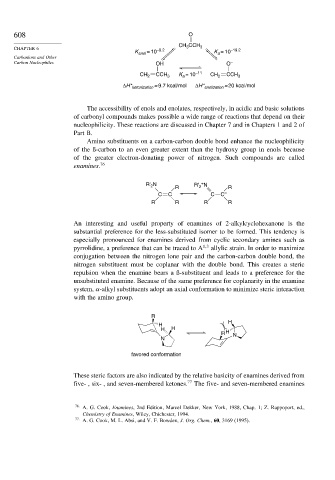Page 626 - Advanced Organic Chemistry Part A - Structure and Mechanisms, 5th ed (2007) - Carey _ Sundberg
P. 626
608 O
CH CCH
CHAPTER 6 3 3
K enol = 10 –8.2 K = 10 –19.2
a
Carbanions and Other
Carbon Nucleophiles OH O –
CH 2 CCH 3 K = 10 –11 CH 2 CCH 3
a
ΔH* ketonization = 9.7 kcal/mol ΔH* enolization = 20 kcal/mol
The accessibility of enols and enolates, respectively, in acidic and basic solutions
of carbonyl compounds makes possible a wide range of reactions that depend on their
nucleophilicity. These reactions are discussed in Chapter 7 and in Chapters 1 and 2 of
Part B.
Amino substituents on a carbon-carbon double bond enhance the nucleophilicity
of the ß-carbon to an even greater extent than the hydroxy group in enols because
of the greater electron-donating power of nitrogen. Such compounds are called
enamines. 76
N +
R' 2 R' N
R 2 R
C C C C –
R R R R
An interesting and useful property of enamines of 2-alkylcyclohexanone is the
substantial preference for the less-substituted isomer to be formed. This tendency is
especially pronounced for enamines derived from cyclic secondary amines such as
pyrrolidine, a preference that can be traced to A 1 3 allylic strain. In order to maximize
conjugation between the nitrogen lone pair and the carbon-carbon double bond, the
nitrogen substituent must be coplanar with the double bond. This creates a steric
repulsion when the enamine bears a ß-substituent and leads to a preference for the
unsubstituted enamine. Because of the same preference for coplanarity in the enamine
system, -alkyl substituents adopt an axial conformation to minimize steric interaction
with the amino group.
R
H
H
H H
R H N
N
favored conformation
These steric factors are also indicated by the relative basicity of enamines derived from
77
five- , six- , and seven-membered ketones. The five- and seven-membered enamines
76 A. G. Cook, Enamines, 2nd Edition, Marcel Dekker, New York, 1988, Chap. 1; Z. Rappoport, ed.,
Chemistry of Enamines, Wiley, Chichester, 1994.
77
A. G. Cook, M. L. Absi, and V. F. Bowden, J. Org. Chem., 60, 3169 (1995).

